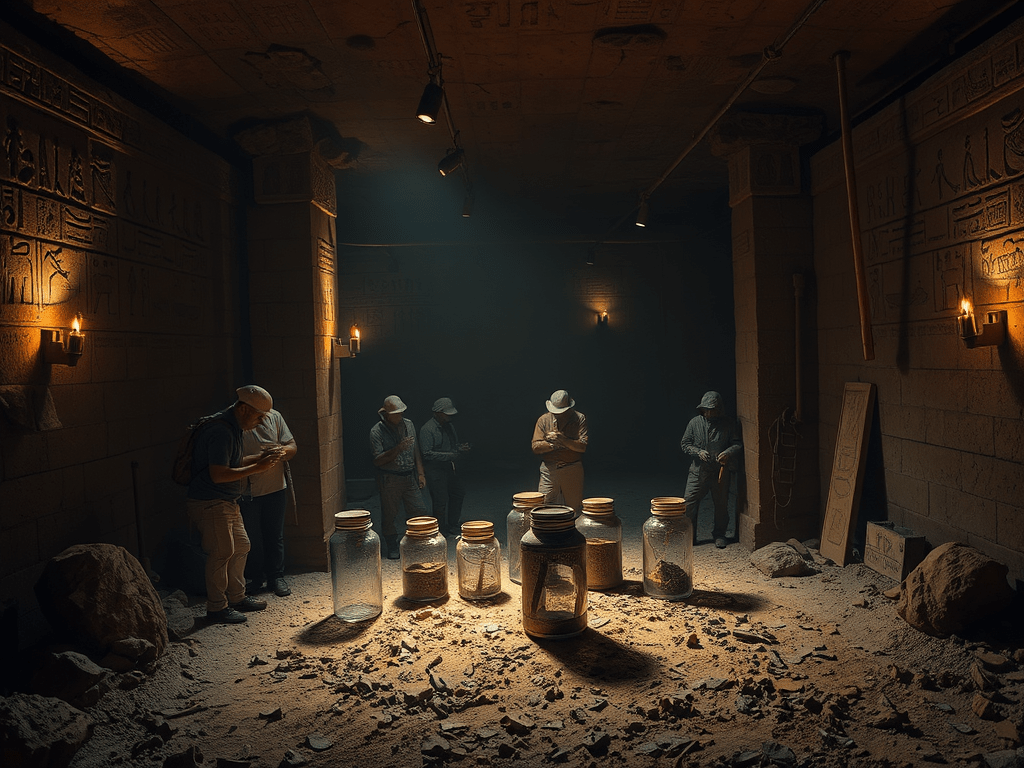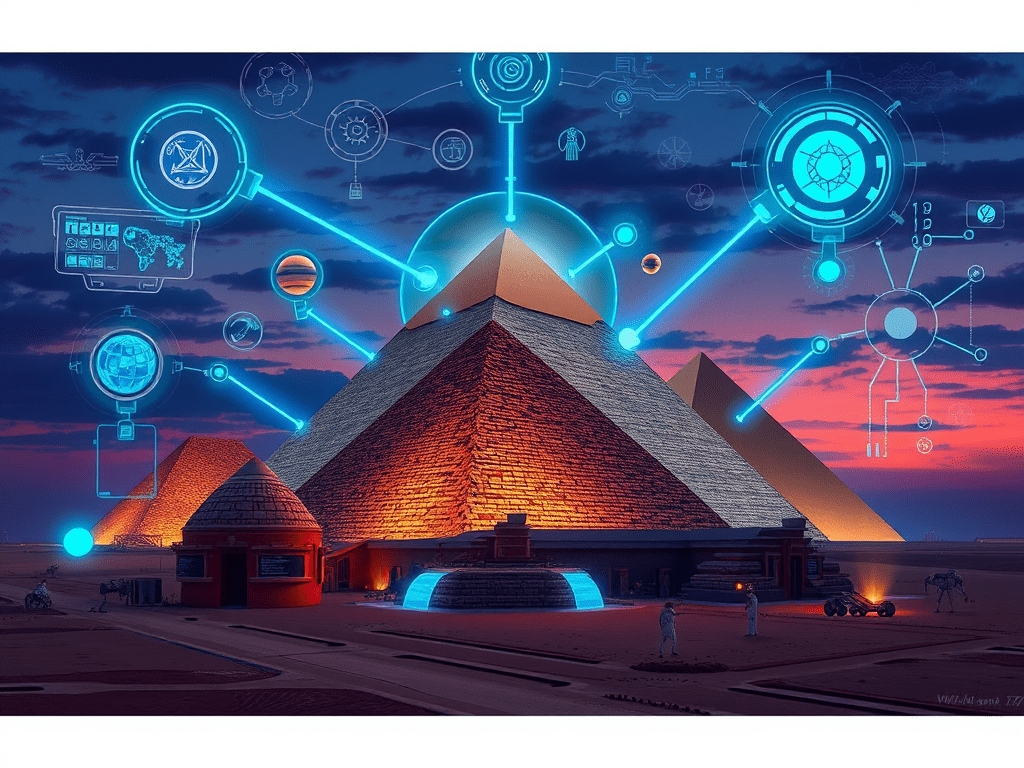Leyden Jars Found Under the Egyptian Pyramids
Leyden jars are among the earliest devices used to store static electricity, serving as the precursor to modern capacitors. Invented in the 18th century by Dutch scientist Pieter van Musschenbroek, these simple yet groundbreaking devices played a significant role in advancing our understanding of electricity. However, some theories and myths have surfaced over the years linking these ancient technologies to the pyramids of Egypt. One such claim suggests that “Leyden jars” were discovered beneath the Egyptian pyramids. In this article, we will explore the history of Leyden jars, their scientific significance, the historical context of the pyramids, and whether there is any truth to these claims.

What Are Leyden Jars?
A Leyden jar is a simple device designed to store static electricity. It consists of a glass jar coated inside and out with metal foil, which acts as conductive plates. A metal rod connected to the inner foil allows the transfer of electrical charge into the jar. Once charged, the jar can store a small amount of electrical energy for a short period.
Invented in 1745, Leyden jars became pivotal tools in early experiments on electricity. They paved the way for the development of modern batteries and capacitors, marking a significant leap forward in human understanding of electrical phenomena.

The History of the Egyptian Pyramids
The Egyptian pyramids are one of humanity’s greatest architectural achievements, constructed during the Old Kingdom period (circa 2600–2500 BCE). These monumental structures were primarily built as tombs for the pharaohs, symbolizing their divine status and ensuring their journey to the afterlife. The Great Pyramid of Giza, built for Pharaoh Khufu, is the most famous and is considered one of the Seven Wonders of the Ancient World.
Archaeological evidence shows that ancient Egyptians used rudimentary tools such as copper chisels and wooden levers to construct the pyramids. Their engineering prowess was remarkable, but there is no indication that they possessed knowledge of electricity or magnetism as we understand it today.

Were Leyden Jars Found Under the Pyramids?
The short answer is no. There is no scientific or archaeological evidence to support the claim that Leyden jars or similar advanced technologies were found beneath the Egyptian pyramids. This idea likely stems from modern conspiracy theories or myths attempting to link ancient civilizations with advanced technology.
- Archaeological Evidence: All discoveries related to the pyramids indicate that they served as tombs for the pharaohs, with a strong emphasis on religious symbolism and spiritual beliefs. No artifacts have been found suggesting the use of electrical or magnetic technologies.
- Modern Scientific Studies: Recent studies using advanced techniques like LiDAR scanning and thermal imaging have analyzed the pyramids. Some of these studies have noted natural electromagnetic properties within the structures, but these phenomena are attributed to the geometric design of the pyramids rather than the presence of ancient devices.
- Conspiracy Theories: Some authors and bloggers promoting “historical conspiracy” or “lost ancient technology” theories claim that the pyramids contain ancient devices like Leyden jars. However, these claims lack scientific backing and often ignore the historical and cultural context of ancient Egyptian civilization.

Why Are the Pyramids Linked to Advanced Technology?
Despite the lack of evidence, the idea of linking the pyramids to advanced technology persists due to several factors:
- Engineering Complexity: The incredible precision in the design and construction of the pyramids leads some to believe that ancient Egyptians used advanced technologies. However, archaeological research shows that this complexity was achieved through collective human effort and meticulous organization.
- Modern Myths: Popular books and films, such as the “Ancient Aliens” series, promote the idea that ancient civilizations possessed advanced knowledge of energy or space. While these narratives add an element of mystery and intrigue, they are often far removed from reality.
- Search for Meaning: The pyramids are seen as enigmatic symbols of human civilization. For some, attributing supernatural or advanced explanations adds greater significance to these structures.

Electromagnetic Properties of the Pyramids
Recent scientific studies have revealed that the pyramids may possess natural electromagnetic properties. For example, researchers from ITMO University in Russia found that the pyramid’s shape can influence the distribution of electromagnetic waves within its structure. However, this phenomenon is attributed to the physical geometry of the pyramid and not to the presence of ancient devices.
- Natural Effects of Shape: Pyramids with triangular shapes can focus electromagnetic energy at specific points. This does not indicate the existence of ancient technologies but is instead a result of the physical properties of geometric shapes.
- Misinterpretations: Some people misinterpret these natural properties as evidence of ancient technologies like Leyden jars, but such interpretations lack scientific support.

Science vs. Fiction
It is crucial to distinguish between scientific facts and fiction when discussing the Egyptian pyramids. While the pyramids demonstrate remarkable engineering complexity, this does not imply the existence of advanced technologies. Ancient Egyptian civilization excelled in fields such as engineering, agriculture, and medicine, but they had no knowledge of electricity or magnetism as we understand them today.
- Science and History: We must rely on scientific and historical evidence when studying ancient civilizations. The pyramids are extraordinary human achievements, but they are not supported by supernatural or advanced technologies.
- Cultural Context: Understanding the cultural and religious context of ancient Egyptian civilization helps us appreciate the pyramids more fully. They were symbols of faith in the afterlife, not tools of advanced technology.
The idea of Leyden jars being found beneath the Egyptian pyramids is more fiction than fact. The pyramids are awe-inspiring feats of engineering that reflect the skills and cultural beliefs of ancient Egyptian civilization. While there may be natural electromagnetic properties associated with the pyramids, these phenomena are explained by their geometric design rather than the presence of ancient technologies.
When discussing ancient civilizations, it is essential to rely on scientific and historical evidence rather than myths or conspiracy theories. The Egyptian pyramids are part of our shared human heritage and should be appreciated for their creativity, spirituality, and cultural significance, not as evidence of supernatural or advanced technologies.
Leyden Jars Found Under the Egyptian Pyramids
Leyden jars are fascinating artifacts in the study of electricity and ancient technology. Recently, reports have emerged suggesting the possibility of Leyden jars being found beneath the Egyptian pyramids, sparking new inquiries into the advanced technology that may have existed within ancient Egyptian civilization.
What are Leyden Jars?
Leyden jars are a type of electrical capacitor invented in the 18th century for storing static electricity. However, the idea of such devices existing in ancient civilizations opens new avenues for scientific and historical discussion.
The Egyptian Pyramids and Advanced Technology
The pyramids, particularly the Great Pyramid of Giza, astonish scholars with their engineering complexity and their ability to endure for over 4,500 years. The potential discovery of Leyden jars beneath these monumental structures could suggest that the ancient Egyptians possessed an advanced understanding of electricity and physics, which paints a new picture of their technological achievements.
Archaeological Evidence
While there is currently no conclusive evidence of Leyden jars being discovered under the pyramids, some researchers and scholars entertain the idea that ancient Egyptians utilized advanced technologies, possibly including electricity storage. This concept raises a dialogue between science and fiction, as many debate the relationship between scientific understanding and myth in the context of ancient Egypt.
Cultural Impact and Supernatural Explanations
There is a growing discourse surrounding the possibility of supernatural explanations for great historical events. Should evidence of these jars be confirmed, it could support theories suggesting that ancient Egyptians had knowledge of electricity derived from unknown sources, thus igniting discussions about potential influences from other civilizations or even hypotheses regarding extraterrestrial beings.
Conclusion
If discoveries confirm the existence of Leyden jars beneath the pyramids, it would open a new chapter in our understanding of ancient technology and human capabilities in those eras. The interplay between science and mythology will continue to be a captivating topic, fueling curiosity about what further revelations may lie ahead.

















